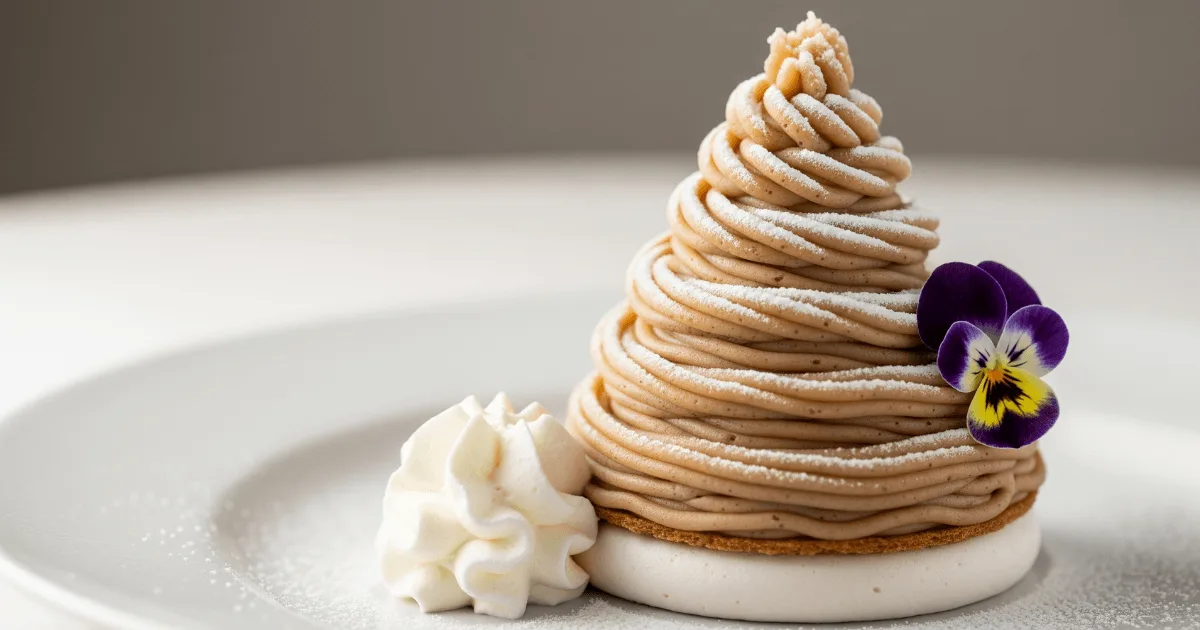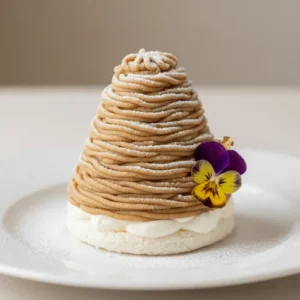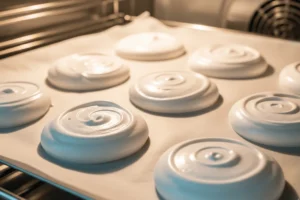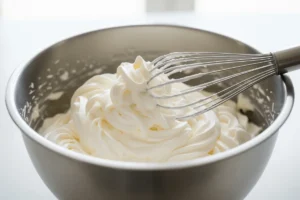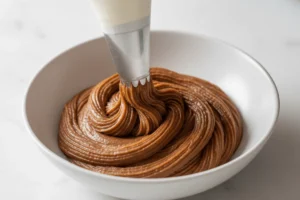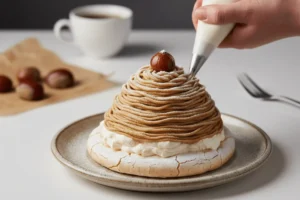Let’s talk about a Mont Blanc dessert that looks like it belongs in a fancy Parisian bakery window, but—plot twist—you can totally make it at home. I’m talking about the Mont Blanc. It’s basically an edible mountain made of chestnuts, cream, and meringue. Sounds luxurious, right? But honestly, it’s not as complicated as it looks. This is my secret weapon when I want to wow people without spending three days in the kitchen. Let’s dive in and get you ready to be the star of your next dinner party.
Table of Contents
So, What Exactly Is a Mont Blanc Dessert?
Picture the prettiest snow-covered mountain you’ve ever seen. Now imagine you can eat it. That’s Mont Blanc (or “Monte Bianco” if you’re feeling Italian). It’s named after the real Mont Blanc mountain in the Alps and gives off cozy autumn and winter vibes.
At its core, it’s just a handful of simple ingredients—but put them together and bam—dessert magic happens. The star flavor is chestnut, which is earthy, nutty, and sweet in the best possible way. Once you have this recipe in your back pocket, you’ll feel like you have a cheat code for fancy desserts.
A Little Drama: The Dessert’s Origin Story
Here’s where it gets fun. France and Italy both claim they invented Mont Blanc. Since the actual mountain sits right on their border, you can see why things turned into a little “he said, she said.”
Some say this dessert goes back to the Middle Ages; others believe it was a Renaissance-era Italian creation. But the version most of us know today really took off in Paris in 1903 at Angelina, a legendary tea room. Their genius idea was adding a crispy meringue base. Just like that, a star was born.
If you ever end up in Paris, trying Mont Blanc at Angelina is basically a foodie rite of passage.
Breaking Down the Bits: What’s In This Thing?
Don’t be fooled by the dramatic look—it’s actually three layers of deliciousness:
- The Base: A light, crunchy meringue (in Japan, sponge cake is sometimes used instead).
- The Star of the Show: Sweetened chestnut puree piped into delicate noodle-like strands. Weirdly beautiful and delicious.
- The Snowcap: A fluffy cloud of whipped cream on top, mimicking snowy peaks. It perfectly balances the rich chestnut layer.
Your Friendlier Mont Blanc Dessert Recipe
Ready to build your edible mountain? Don’t worry—I’ll walk you through it step by step.
Mont Blanc Dessert
Equipment
- 1 Mixing bowls
- 1 Electric mixer or hand whisk
- 1 Piping bags with round or spaghetti-style nozzle
- 1 Baking tray
- 1 Parchment paper
- 1 Spatula
- 1 Spoon
- 1 Cooling rack
- 1 Fine sieve for dusting powdered sugar)
Ingredients
For the Meringue Base (optional but classic):
- 3 large egg whites room temperature
- ¾ cup granulated sugar
- ½ tsp cornstarch
- ½ tsp lemon juice or white vinegar
For the Chestnut Cream:
- 1 Cup sweetened chestnut puré (250 g) or chestnut spread/cream
- 2 tbsp unsalted butter (softened)
- 2 tbsp powdered sugar
- 1–2 tbsp dark rum (optional, but traditional)
- 1 tsp vanilla extract
For the Whipped Cream Filling:
- 1 cup (240 ml) heavy cream (240 ml) (chilled)
- 2 tbsp powdered sugar
- ½ tsp vanilla extract
For Decoration:
- Extra chestnut purée (for piping “spaghetti” strands)
- Powdered sugar (for dusting)
Instructions
Step 1: Make the Meringue Base
- Preheat oven to 250°F (120°C). Line a baking tray with parchment paper.
- Whip the egg whites until foamy, then slowly add sugar while beating until stiff peaks form.
- Gently fold in cornstarch and lemon juice.
- Pipe or spread into small discs (about 3-inch rounds).
- Bake for 1.5 hours until crisp, then let cool completely in the oven with the door slightly open.
Step 2: Prepare the Whipped Cream
- In a chilled bowl, whip heavy cream with powdered sugar and vanilla until soft peaks form.
- Keep refrigerated until use.
Step 3: Make the Chestnut Cream
- In a bowl, beat chestnut purée with butter, powdered sugar, vanilla, and rum until smooth and creamy.
- If too thick, add 1–2 tbsp of cream to loosen.
- Transfer to a piping bag fitted with a small round or spaghetti-style nozzle.
Step 4: Assemble the Mont Blanc
- Set a cooled meringue disc on a plate for serving.
- Pipe or spoon a mound of whipped cream in the center (like a little mountain).
- Cover the whipped cream with piped chestnut cream strands, spiraling to create the famous “mountain” look.
- Apply a gentle dusting of powdered sugar to achieve a snow-like look.
Notes
Nutrition per serving, approx. 1/6 of the recipe
- Calories: 350 kcal
- Carbohydrates: 50 g
- Sugars: 40 g
- Protein: 4 g
- Fat: 15 g
- Saturated Fat: 9 g
- Fiber: 3 g
- Cholesterol: 45 mg
- Sodium: 40 mg
Mont Blancs Around the World
Mont Blanc Desser has quite the passport.
Japan’s Passion for Mont Blanc (Monburan)
Japan is absolutely obsessed with it—introduced in the 1930s by baker Chimao Sakota.
- Flavors: Matcha, sweet potato, and even red bean versions.
- Style: Tokyo bakeries often create multi-layered works of edible art.
Other Fun Twists
- Italian Style: Sometimes boozier, with cocoa or rum notes.
- Coffee Inspired: There’s even Mont Blanc coffee topped with frothy cream “snow.”

FAQ
What’s actually in it?
Three components: crunchy meringue, chestnut puree “noodles,” and whipped cream snow on top.
Is there an Albanian version?
Not really—this dessert is primarily a French, Italian, and Japanese affair.
What’s the history again?
It’s a centuries-old tug-of-war between France and Italy. Angelina in Paris made it world-famous in 1903.
So… who invented it?
No clear winner. Anton Rumpelmayer (Angelina’s founder) is credited with the modern Mont Blanc, and Japan’s Chimao Sakota helped spread the hype globally.
Conclusion
And there you have it—Mont Blanc Dessert. It looks like something you’d need a pastry degree to pull off, but really, it’s a fun weekend project. Once you try it, you’ll realize it’s not just a pretty dessert—it’s ridiculously tasty, too.
So go on, build your little mountain. Worst case, you’ll “accidentally” eat some whipped cream along the way. Best case, you’ll have a showstopper that makes everyone at the table gasp. Either way, you win.

